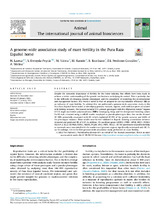Mostrar el registro sencillo del ítem
A genome-wide association study of mare fertility in the Pura Raza Español horse
| dc.contributor.author | Laseca, Nora | |
| dc.contributor.author | Demyda-Peyrás, S. | |
| dc.contributor.author | Valera Córdoba, M. | |
| dc.contributor.author | Ramón, M. | |
| dc.contributor.author | Escribano, Begoña M. | |
| dc.contributor.author | Perdomo-González, Davinia I. | |
| dc.contributor.author | Molina, Antonio | |
| dc.date.accessioned | 2024-01-17T11:25:50Z | |
| dc.date.available | 2024-01-17T11:25:50Z | |
| dc.date.issued | 2022 | |
| dc.identifier.issn | 1751-732X | |
| dc.identifier.uri | http://hdl.handle.net/10396/26589 | |
| dc.description.abstract | Despite the economic importance of fertility for the horse industry, few efforts have been made to achieve a better understanding of the genetic mechanisms underlying its control. This is probably due to the difficulty of obtaining reliable phenotypes and the complexity of modelling the environmental and management factors. This work is novel in that we propose to use reproductive efficiency (RE) as an indicator of mare fertility. To achieve this, we performed a genome-wide association study in the Pura Raza Español horse aimed at identifying genomic variants, regions, and candidate genes associated with fertility in mares. The dataset included 819 animals genotyped with the Affymetrix Axiom™ Equine 670 K single-nucleotide polymorphisms (SNPs) Genotyping Array and the deregressed breeding values for RE trait, obtained using a ssBLUP model, employed as pseudo-phenotypic data. Our results showed 28 SNPs potentially associated with RE, which explained 87.19% of the genetic variance and 6.61% of the phenotypic variance. Those results were further validated in BayesB, showing a correlation between observed and predicted RE of 0.57. In addition, 15 candidate genes (HTRA3, SPIRE1, APOE, ERCC1, FOXA3, NECTIN-2, KLC3, RSPH6A, PDPK1, MEIOB, PAQR4, NM3, PKD1, PRSS21, IFT140) previously related to fertility in mammals were associated with the markers and genomic regions significantly associated with RE. To our knowledge, this is the first genome-wide association study performed on mare fertility. | es_ES |
| dc.format.mimetype | application/pdf | es_ES |
| dc.language.iso | eng | es_ES |
| dc.publisher | Elsevier | es_ES |
| dc.rights | https://creativecommons.org/licenses/by-nc-nd/4.0/ | es_ES |
| dc.source | Animal; 16 (3): 100476 (2022) | es_ES |
| dc.subject | Association analysis | es_ES |
| dc.subject | Candidate genes | es_ES |
| dc.subject | Single-nucleotide polymorphisms | es_ES |
| dc.subject | Equine reproductive traits | es_ES |
| dc.title | A genome-wide association study of mare fertility in the Pura Raza Español horse | es_ES |
| dc.type | info:eu-repo/semantics/article | es_ES |
| dc.relation.publisherversion | https://doi.org/10.1016/j.animal.2022.100476 | es_ES |
| dc.relation.projectID | Gobierno de España. AGL-2017-84217-P | es_ES |
| dc.relation.projectID | Gobierno de España. PICT2018-0227 | es_ES |
| dc.relation.projectID | Gobierno de España. PRE 2018-083492 | es_ES |
| dc.rights.accessRights | info:eu-repo/semantics/openAccess | es_ES |

